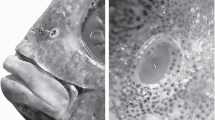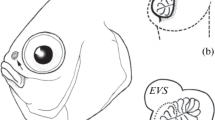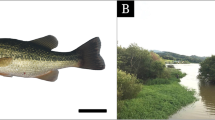Summary
-
1.
The olfactory organs of 37 species of oviparous cyprinodonts belonging to the sub-families Rivulinae, Aphaniinae, Fundulinae, Cyprinodontinae, Procatopodinae and Orestiatinae are studied.
-
2.
The organs consist of a usually flat olfactory chamber and an accessory sac. The olfactory chamber is lined with the olfactory mucosa and has two openings: an anterior incurrent nostril and a valvular posterior excurrent nostril.
-
3.
Some of the species differ conspicuously in the olfactory chamber and its openings and in the topographic position of the accessory sac.
-
4.
Most of the sensory epithelium, which is part of the olfactory mucosa, is separated into distinct areas by more or less prominent ridges. These ridges are compared with secondary lamellae which are found on olfactory folds of some other fish species for structure, ontogeny and supposed function.
-
5.
Four types of arrangement of the olfactory mucosa can be distinguished: whereas there are no significant differences in five of the sub-families, in the rivulins three types are found. These are geographically separately distributed.
-
6.
The relationship of the different systematic units is discussed in relation to the structural variation in the different types of olfactory organs.
Zusammenfassung
-
1.
Es wird das Geruchsorgan von 37 Arten oviparer Zahnkarpfen (Familie Cyprinodontidae) untersucht, die 21 Gattungen aus den Unterfamilien Rivulinae, Aphaniinae, Fundulinae, Cyprinodontinae, Procatopodinae und Orestiatinae angehören.
-
2.
Die Geruchsorgane bestehen aus einer mit Riechschleimhaut ausgekleideten, meist niedrigen Riechhöhle Bowie einem akzessorischen Ventilationssack. Die Riechhöhle besitzt zwei Öffnungen, eine Einström- und eine mit einem Klappenventil versehene Ausströmoffnung.
-
3.
In der Form der Riechöffnungen, in der Ausgestaltung der Riechhöhle und in der topographischen Lage des akzessorischen Ventilationssackes gibt es zwischen einigen Arten auffallende Unterschiede.
-
4.
Das Sinnesepithel, Bestandteil der Riechschleimhaut, ist zumeist von Wülsten durchsetzt, die mehr oder weniger stark räumlich hervortreten. Sie werden in ihrem Aufbau und ihrer Ontogenese Bowie in ihrer mutmaßlichen Funktion mit Sekundärfalten verglichen, die auf Riechfalten in den Geruchsorganen mancher anderer Fishhe vorkommen.
-
5.
In der Art der Anordnung der Riechschleimhaut werden vier Typen unterschieden. Während bei Vertretern aus fünf Unterfamilien die Art der Anordnung einheitlich ist, werden allein bei den rivulinen Zahnkarpfen drei Typen gefunden, die in ihrem Vorkommen geographisch getrennt sind.
-
6.
Die unterschiedlichen Merkmalsausprägungen werden im Zusammenhang mit Fragen der verwandtschaftlichen Beziehungen zwischen den einzelnen systematischen Gruppen diskutiert.
Similar content being viewed by others
Abbreviations
- Bi:
-
Bindegewebe
- Bg:
-
Blutgeföß
- hRö:
-
hintere Riechöffnung
- iE:
-
indifferentes Epithel
- Kv:
-
Klappenventil
- O:
-
Olfaktoriuszweige
- Rhb:
-
Riechhöhlenboden
- Rhd:
-
Riechhöhlendach
- Rhl:
-
Riechhöhlenlumen
- SE:
-
Sinnesepithel
- vRö:
-
vordere Riechöffnung
- Vs:
-
akzessorischer Ventilationssack
Literatur
Aleev, Yu. G.: Function and gross morphology in fish (translated by M. Raveh). Jerusalem: Keter Press 1969
Bertmar, G.: Lungfish phylogeny. Nobel Symposium 4, T. Ørvig, Ed., p. 259–283. Stockholm: Almquist & Wiksell 1968
Bertmar, G.: The vertebrate nose, remarks on its structural and functional adaptation and evolution. Evolution 23, 131–152 (1969)
Bertmar, G.: Secondary folding of olfactory organ in young and adult sea trout. Acta zool. (Stockh.) 53, 113–120 (1972a)
Bertmar, G.: Scanning electron microscopy of olfactory rosette in sea trout. Z. Zellforsch. 128, 336–346 (1972b)
Bertmar, G.: Ecostructural studies on olfactory organ in young and adult sea trout (Osteichthyes, Salmonidae). Z. Morph. Tiere 72, 307–330 (1972c)
Foster, N. R.: Trends in the evolution of reproductive behavior in killifishes. Stud. trop. oceanogr. 5, 549–566 (1967)
Hennig, A.: Volumen- und Oberflächenmessung in der Mikroskopie. Verh. anat. Ges., Erg.-H., Anat. Anz. 104, 254–265 (1957)
Hoedeman, J. J.: On the probable evolution of the frontal scalation patterns. Studies on cyprinodontiform fishes, 10. Bull. aquat. Biol. 2, 82–92 (1961)
Holl, A.: Vergleichende morphologische und histologische Untersuchungen am Geruchsorgan der Knochenfische. Z. Morph. Ökol. Tiere 54, 707–782 (1965)
Holl, A.: Funktionsmorphologie der Nase von Chimaera monstrosa (Holocephali). Z. Morph. Tiere 74, 271–296 (1973)
Iwai, T., Nakamura, J.: Olfactory organs of tunas with special reference to their systematic significance. Bull. Misaki Mar. Biol. Inst. 7, 1–8 (1964)
Moulton, D. G., Beidler, L. M.: Structure and function in the peripheral olfactory system. Physiol. Rev. 47, 1–52 (1967)
Pfeiffer, W.: The morphology of the olfactory organ of the pacific salmon (Oncorhynchus). Canad. J. Zool. 41, 1233–1236 (1963)
Pfeiffer, W.: Das Geruchsorgan der rezenten Actinistia und Dipnoi (Pisces). Z. Morph. Tiere 64, 309–337 (1969)
Romeis, B.: Mikroskopische Technik, 16. Aufl. München-alien: Oldenbourg 1968
Rosen, D. E.: The relationships and taxonomic position of the halfbeaks, killifishes, silversides, and their relatives. Bull. Amer. Mus. Nat. Hist. 127, 217–268 (1964)
Rosen, D. E., Bailey, R. M.: The poeciliid fishes (Cyprinodontiformes), their structure, zoogeography, and systematics. Bull. Amer. Mus. Nat. Hist. 126, 1–176 (1963).
Scheel, J.: Rivulins of the world. Jersey City: T. F. H. Publications 1968
Schemmel, C.: Vergleichende Untersuchungen an den Hautsinnesorganen ober- und unterirdisch lebender Astyanax-Formen. Z. Morph. Tiere 61, 255–316 (1967)
Sethi, R. P.: Osteology and phylogeny of oviparous cyprinodont fishes (order: Cyprinodontiformes). Ph. D. Thesis, Univ. Florida, xiii-275p (unveröfftl., Mikrofilm) (1960)
Stenholt Clausen, H.: Tropical old world cyprinodonts. København: Akademisk Forlag 1967
Sterba, G.: Süßwasserfische aus alley Welt. Melsungen-Berlin-Basel-Wien: Neumann-Neudamm 1970
Uyeno, T., Miller, R. R.: Relationships of Empetrichthys erdisi, a pliocene cyprinodontid fish from California, with remarks on the Fundulinae and Cyprinodontinae. Copeia 3, 520–532 (1962)
Villwock, W.: Genetische Untersuchungen an altweltlichen Zahnkarpfen der Tribus Aphaniini (Pisces, Cyprinodontidae) nach Gesichtspunkten der Neuen Systematik. Z. zool. Syst. Evol.-forsch. 2, 267–382 (1964)
Weibel, E., Elias, H.: Introduction to stereology and morphometry. Quantitative methods in morphology, Weibel, E., Elias, H., Eds., p. 3–19. Berlin-Heidelberg-New York: Springer 1967a
Weibel, E., Elias, H.: Introduction to stereology principles. Quantitative methods in morphology, Weibel, E., Elias, H., Eds., p.87–98. Berlin-Heidelberg-New York: Springer 1967b
Zeiske, E.: Morphologische Untersuchungen am Geruchsorgan von Zahnkarpfen (Pisces, Cyprinodontoidea). Z. Morph. Tiere 74, 1–16 (1973)
Author information
Authors and Affiliations
Additional information
Mit Unterstützung der Deutschen Forschungsgemeinschaft.
Rights and permissions
About this article
Cite this article
Zeiske, E. Morphologische und morphometrische untersuchungen am geruchsorgan oviparer zahnkarpfen (Pisces). Z. Morph. Tiere 77, 19–50 (1974). https://doi.org/10.1007/BF00284625
Received:
Issue Date:
DOI: https://doi.org/10.1007/BF00284625




